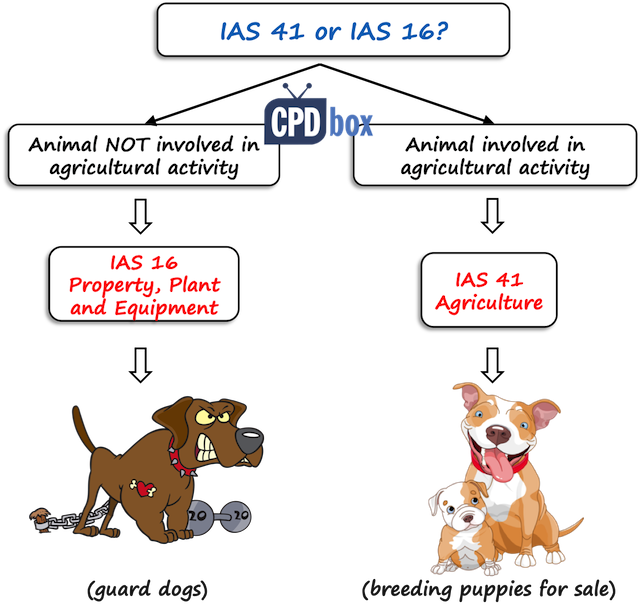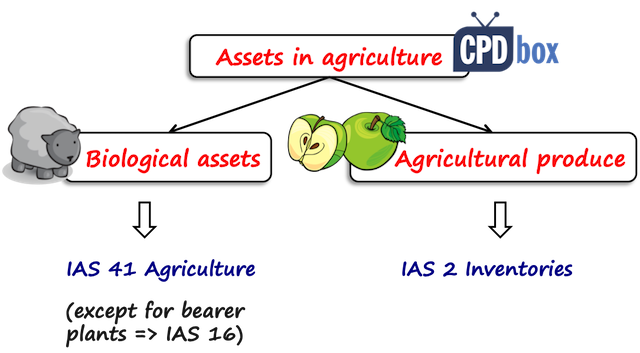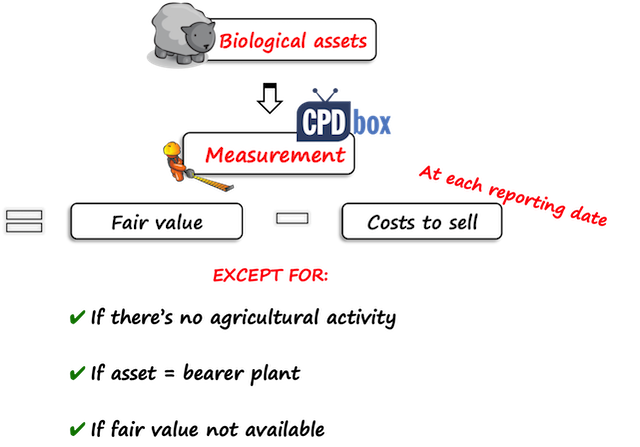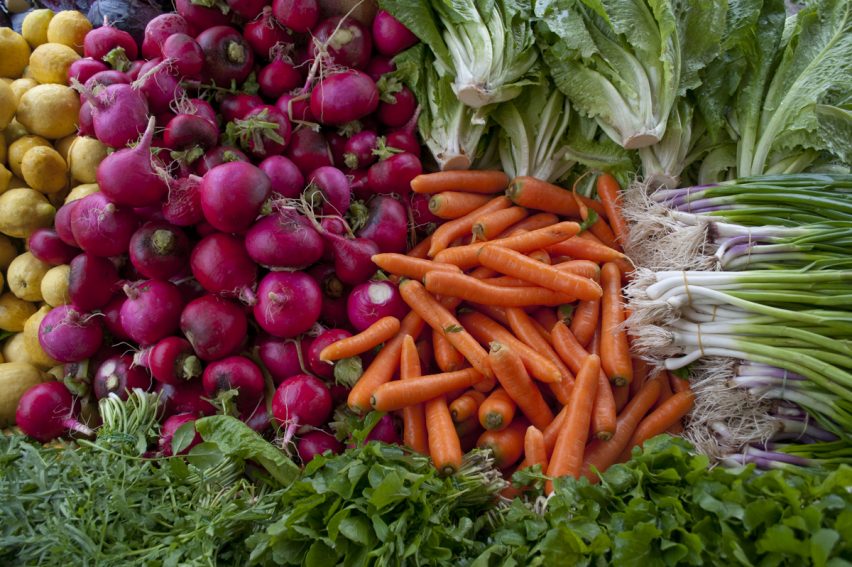Top 3 Questions about IAS 41 Agriculture
I rarely publish articles about specific sectors, but this time, I decided to make an exception.
Why?
The reason is that although most of you do NOT deal with agriculture, it is still one of the most important industries in the world.
It is so important and so different from other industries that it has its own standard – IAS 41 Agriculture.
In many developing countries, agricultural activities represent one of the most important sources of income.
After all – we all need to eat (unless you’re breatharian). This tells it all about the importance of agriculture.
Unlike other industries, agriculture works with living animals and plants. By definition, living animals and plants are born, grow and die.
Therefore, a few problems arise when it comes to accounting for and reporting the results of agricultural businesses.
So, if you’re into agricultural business, or you just need to familiarize yourself, keep on reading. Maybe you’ll be surprised to find out that agriculture can hide in very improbable places!
Question #1: Is it agriculture?
The first and primary question when dealing with living plants and animals is – what is agricultural activity?
It is the management of the biological transformation (e.g. growth) of biological assets for (IAS 41.5):
- Sale, or
- into agricultural produce, or
- into additional biological assets.
You have to make your best effort to answer that question correctly, because the accounting and reporting depends on it.
Why?
Imagine you have a dog.
Logically, it is a living animal, and therefore it is a biological asset. You might think: “well, biological assets are governed by IAS 41, so I need to measure the dog at fair value at the end of each year”.
Not so fast.
Why do you have that dog?
Is it a guard dog, protecting your property and barking at everyone passing by?
If yes, then you should NOT apply IAS 41, but IAS 16 Property, plant and equipment and measure the dog at cost less accumulated depreciation.
The reason is that protecting the property is NOT an agricultural activity and IAS 41 does NOT apply.
Or, do you have that dog in order to produce and raise puppies and sell the puppies?
In this case, IAS 41 applies, because breeding and selling puppies is an agricultural activity.

So, if you think that OK, I’m not a farmer, so I don’t need to bother with IAS 41, you might be surprised where the agriculture can hide.
Just a few examples:
- Pharmaceutical companies
Some pharma companies grow their own plants in order to produce drugs. Yes, this is an agricultural activity and IAS 41 applies. - Diary producers
If a company grows its own bacteria and cultures and then adds them to its yoghurts, well – this is an agricultural activity and IAS 41 applies. - Jewelry producers
Some big jewelry producers produce their own pearls by planting foreign objects (such as pieces of shells or parasites) into the soft bodies of living oysters. Then, the oyster produces a pearl by secreting crystalline substance around the object to protect itself. Yes, this is an agricultural activity and IAS 41 applies.
On the other hand, not everything involving living plants or animals is agricultural activity.
Again, few examples:
- ZOO
The main purpose of the ZOO (and safari, recreational park, riding hall, etc.) is to make money from showing the animals off to the public – this is NOT an agricultural activity and IAS 41 does NOT apply (IAS 16 does).Yes, animals living in the ZOO sometimes pair and produce a baby – but if it’s a natural process, not managed by the ZOO, it is NOT an agricultural activity.
The situation would be different when the ZOO would implement an active program of reproduction and managed that program. In this case, breeding animals would NOT be an incidental and ZOO would have to apply IAS 41.
- Fishing
All fishermen catching fish in the ocean can breathe with relief. If you are NOT actively farming fish, but you’re merely harvesting the fish from the ocean, it’s NOT an agricultural activity.The reason is that fish grew naturally in the ocean, which was NOT an agricultural activity.
The same applies for hunting and other similar activities of harvesting biological assets from nature.
- “Working animals”
When you hold an animal primarily to do some work, such as cart-horses, guard dogs, elephant taxis, etc., then you do NOT apply IAS 41, because all these activities do NOT represent biological transformation.Instead, IAS 16 is the right way to go.
Question #2: Is it a biological asset?
Very common misconception in the agriculture accounting is the belief that everything coming out of agriculture is a biological asset.
Not true.
Biological assets are only living plants and animals.
The harvested products of biological assets are agricultural produce.
Apples, palm oil, pearls, milk, coffee beans, tea leaves – all this is agricultural produce.
Why do we bother?
Well, once you detach the agricultural produce from a biological asset, in other words – once you harvest the produce, it becomes your inventories and you apply IAS 2 Inventories.

At the moment of harvest, you should measure your new inventories at their fair value less costs to sell and subsequently, you measure them under IAS 2 at lower of cost and net realizable value.
You do NOT remeasure agricultural produce to fair value less cost to sell.
Question #3: Are biological assets always measured at fair value less costs to sell?
No, they are not.
It is true that the general rule in IAS 41 Agriculture is to measure all biological assets at fair value less costs to sell.
However, there are few exceptions:
- The biological asset is NOT a part of agricultural activity.
I’ve explained it above – guard dogs, fish caught in the ocean, etc.
- The biological asset is a bearer plant.
This is a relatively new thing in both IAS 41 and IAS 16 adopted in 2014.
A bearer plant is a living plant used in production or supply of agricultural produce that is expected to produce for more than 1 period.
Special For You! Have you already checked out the IFRS Kit ? It’s a full IFRS learning package with more than 40 hours of private video tutorials, more than 140 IFRS case studies solved in Excel, more than 180 pages of handouts and many bonuses included. If you take action today and subscribe to the IFRS Kit, you’ll get it at discount! Click here to check it out!
The examples are fruit trees, oil palms, vines etc.As it was difficult and impractical to set the fair value of these assets at the end of each reporting period, they were taken out of IAS 41’s scope.
So, you can keep these assets at cost less accumulated depreciation under IAS 16.
Careful – this is only about plants, not animals. So, if you own expensive dogs and use them to breed new dogs, then sorry, it’s NOT a bearer plant.
- The fair value is not reliably measurable
When the fair value cannot be measurable, you can measure the asset at its cost less accumulated depreciation.
However, this is almost never relevant and IAS 41 says that the fair value CAN be measured reliably for biological assets.
Also, this exemption is available ONLY at initial recognition, never later. So, if you received the biological asset as a gift and market prices are not available, you would be able to use cost model.
Other situations are highly unlikely.

Further reading
In this article, I outlined just a few critical questions related to the correct reporting of agricultural activities.
We haven’t even touched other things, like how to set the fair value of biological assets and harvested produce, or example of accounting for agricultural activity from the beginning to the end.
Here’s the list of a few articles on CPDbox that I strongly recommend to read (and watch the attached video) to educate yourself about agriculture:
- Summary of IAS 41 Agriculture (with video included)
- How to account for expenses related to agricultural activity?
- How to measure fair value in agriculture
Until then, please leave a comment right below this video and let me know your own agricultural issues. I’ll try to help out!
Tags In
JOIN OUR FREE NEWSLETTER AND GET
report "Top 7 IFRS Mistakes" + free IFRS mini-course
Please check your inbox to confirm your subscription.
Recent Comments
- Silvia on Accounting for gain or loss on sale of shares classified at FVOCI
- Silvia on Lease term when contract is for indefinite period
- H on Accounting for gain or loss on sale of shares classified at FVOCI
- jibril Tegenu on IFRS 18 Presentation and Disclosure in Financial Statements: summary
- Alexei Estrella on Lease term when contract is for indefinite period
Categories
- Accounting Policies and Estimates (14) 14
- Consolidation and Groups (25) 25
- Current Assets (21) 21
- Financial Instruments (56) 56
- Financial Statements (54) 54
- Foreign Currency (9) 9
- IFRS Videos (73) 73
- Insurance (3) 3
- Most popular (6) 6
- Non-current Assets (55) 55
- Other Topics (15) 15
- Provisions and Other Liabilities (46) 46
- Revenue Recognition (26) 26
- Uncategorized (1) 1




why do we recognise the guard dogs as a ppe when they don’t meet recognition criteria of a ppe(inflow of economic benefits should be probable and cost be measured reliably)?
Tendani, guard dogs in most cases meet both of these criteria.
How do I measure game animals, particularly the lions?
Well, if there is a market for these animals, then with reference to their market price.
Hi Silvia where do you get Pictures from ?
They are such a fun with reading
Hi Silvia, thanks for the nice article.
Btw, i have some question.
If the agricultural produce is still attached to the bearer plant (e.g. palm fruit that not mature enough to harvest and still attached to the palm tree), how we apply disclosure and measurement in the FS? Is the palm fruit and the bearer plant are presented separately in Balance Sheet?
Thanks in advance!
This is a great question. The palm fruit that is still attached to the palm, is NOT an agricultural produce. Agricultural produce is HARVESTED, by definition in IAS 41. If it is still on the palm tree, then you would show the palm tree only. S.
Hi Silvia
Would the fruit on the tree not be biological assets as according to 5C of IAS 41 “Produce growing on bearer plants is a biological asset” lets say its an avocado tree
Simply Amzaing
Hi Silvia,
Small question!
The harvested agricultural produce from the biological assets are measured at fair value less cost to sell and accounted under inventories (LKAS 02). Subsequently it should be measured at the lower of cost or NRV according to the requirement of LKAS 02.
At the subsequent measurement of these inventories, the cost of the agricultural produce should be fair value less cost to sell if i am not mistaken
Plz advise me
Subsequently, you measure these inventories either at cost (that is the fair value less cost to sell AT THE POINT OF HARVEST), or NRV (net realizable value = fair value less cost to sell AT THE REPORTING DATE), whichever is lower. S.
Thank you so much
This is very helpful, am able to follow.
Excellent…. ! That was explained in its best possible way.
I got a question Silvia, though it’s not over IAS 41 or 16. That is related to IFRS 15 (contract with customers)
When we give discount to customers, it is considered above the calculation of ‘Net Revenue’… What if, instead of selling at discount price, we could give them goods / gifts worth of that discount amount ? Can this be considered as Discount ?
Or this needs to considered as Cost of Sales, which is below the ‘Net Revenue’ calculation
Hi Silvia
I think you clarify my doubt. Really the Forum would be a fantastic idea.
I would like to help you, but I do not dominate the English language perfectly as well as you or other from english countries .
But, you launched the idea. Who can help you?
Anyway, thanks a lot por you attention.
Carlos
Dear Carlos,
 S.
S.
English is not my native language. That’s a fact. English is my second language and if you are careful listener, you can hear it
Well, I would need someone to help me moderate the forum and respond the questions, because I just can’t do it myself, it’s a huge workload
Folks
I would be glad in taking the opportunity but need more than one / group of people to have it more interactive
thank you for an informative lecture. i was only aware of 1 reason why we measure biological asset at cost
No doubt about your article. Fantastic and very, very positive. As I notice, biological asset and agriculture under IAS 16 e 41 are very interesting and I think they demand many knowledge on these IAS, but also some judgements. Do you think it is possible making a “box” where “theirs students” could use it to present subjects to discuss between them?
Hi Carlos,
what “box” do you mean? I wanted to launch a forum here on my box, but it requires lots of admin interventions (otherwise you end up with lots of spam there) and at the moment, I put it off as I have no time for that. But if there’s someone wishing to help… then I would do it
Hi Silvia, Could you please advise should we capitalize expenditures spent for greenery services, green trees as assets for company area improvement.
thank you
Hi Mira, it depends whether the “greenery services” maintain the area, or actually enhance it. E.g. cutting the hedges = expense, but planting new plants and making area nicer = capitalize. S.
Dear Silva, I thank your for making IFRS for easy understanding.My problem is why accounting for bearer plants different from bearer animals. After all animals like dogs and cows reproduce over many years. Please I need clarification.
thanks. Doumu.
Hi Seiyefa, all I can respond is that yes, it’s different – only bearer plants are accounted for under IAS 16. It’s the rule.
Thanks Silvia M.
You are really special regarding IFRS. Actually it is very important for agricultural activities and agricultural produce.
Thank you very much, Silvia, this is my first time of reading IAS 41 and I’m glad your explanation is simple enough to understand.
Please i work for a onstruction company but recently the company bought a land and rented some land for cassava plantation ,Pig farming and cow rearing.Please ma ,how should i treat this in the financial statement .I am really lost and need help .please what is the treatment.
Thank you.
Hi Adedeji,
well, the land is out of scope of IAS 41, so it’s IAS 16 Property, plant and equipment. As for the rental, it depends on whether the company applies new lease standard IFRS 16 or the older IAS 17. S.
Thanks Silvia…very useful. Looking foward to your next article, have a client who is involve in fishing. Keen to learn hw should they account for the harvest. Am sure they are getting it wrong at the moment.
Dear Sylvia,
In the pig farming business, one has a dedicated number of specially selected sows to produce piglets. It is clear that the piglets meant for sale are biological assets but are the sows which are not meant for sale, be considered as bearer plants and treated under IAS 16?
Hi Neneyo, no, sows are not bearer plants, because they are not plants – they are animals. S.
Thank you lot for updating us for every IFRS
Hi Silva, I enjoyed reading your post about IFRS, you simplified it in a simpler form. Keep up with the good work ma. God bless
I love how you teach through your articles. I have learnt so much from you since I started reading your articles.
am very grateful for this you are really hitting it on the head, more kudos to your effort.
thanks. my regards to your family.
Thanks a lot Sylvia for this! If I get you correctly only farm produce and processed animals are treated as inventories under IAS 2 because they are non living. I don’t however understand the basis of moving only bearer plants from IAS 41. there are also bearer animals and I believe that in most cases it may be impracticable to fair value them(my opinion though). That allows you to use cost less depreciation. Isn’t it wise therefore to move the bear animals too from this standard?
Thanks.
Dear Mark,We have to expense them. Previously such costs were capitalized in GAAP. But in IAS 41 the standard keeps silent regarding these expenses.
Thanks silvia for this article. I just have one question if you don’t mind. With regards to bearer plants, how will you account the insecticides and pesticides applied for their fruits? Should we capitalized these costs? Or expensed outright?
Hi Silvia,
Well written and very explicit. Thanks for sharing.
Regards,
TP Anand
Awesome article Silvia! You made accounting for agricultural activity sound very exciting! Makes me wish I worked in a firm dealing with agricultural activity.
Very explicit. Thanks
Silvia. Very interesting article. So to my understanding a company whose business is in Fish Farming (buys small fish , places them in fish pens, feed them and then when they reach the desirable/saleable size they are harvested and sold) , then IAS 41 applies. Correct?
thanks and regards
Ruth
Yes, correct
Silva, Really you are amazing.
Let me call you the “Qween of IFRS” !
Thank you for your easy as well as logical explanation.
Thank you a lot.
Dear Ashraf, well, it’s flattering and I thank you for that, but I think that true “queens and kings” of IFRS are sitting there in the IASB creating the standards
Hello,
I am a business graduate from a public university major in Accounting and Information Systems. Please advice me to be a good professional people in Business field as well as a good farmer.
Jalilur Rahman
Well educate.am actaully interested to know more about this study,most chartered accountants over look this standard and as a result we have little understanding about it.
And more over,this less examined in most Financial reporting questions.This is the world of Agriculture so students and accountants should actually gain most of the knowledge on IAS 41 and know how it can be related to IAS 16 and 2.
Thanks.
chishala
Thanks a lot for this piece. Please 2 cows died from the flock of 23 cows we rear for reproduction. How do I account for this?
One of our pigs littered 7 piglets yesterday but 2 died, how do we account for this.
Thanks.
Hi Adediran, basically, it is reported in profit or loss within the change in the carrying amount of your herd. You should separately report what change was caused by the change in prices and change in physical quantities. As promised, I will write something in the future with examples. S.
Hello,
I’m working in a company that have the initial growth in a 17-year pine Cupressaceae plantation production cycle.
What is the best method to measure the cost of this?
Bregards,
Hello, John, I’ll write up more about the measurement of biological assets in some of my future articles. Kind regards, S.
When I first go through your introductory video on IFRS, you motivated everyone to believe that IFRS are not that complex. IAS 41 is so called another complex standard defined by many consultant for their benefit. Having that, we appreciate your tremendous work always which is freely available. In fact buying IFRS box for that price is really worth. It helps me lot to train our audit staff here. Pls let us know how best I can help you for future projects.
Thank you, Jerad, I appreciate your kind words and your offer, too
Thanks Silvia, your articles bring simplicity in understanding financial reporting. To be honest my mind has never accepted bearer plants being accounted for under IAS 16,,In my own view its too much of theory and better had it remained in IAS41
Am very happy this IAS 41 on Agriculture. Pls I need complete IAS books and IFRS for my personal development and updating. Oladipupo from Nigeria
Hello Silvia,I must say you are an awesome teacher.The simplicity in your explanations is really amazing.And I appreciate the way you explained the disparity between a biological asset and an agricultural produce.I definitely will get your IFRS kits anytime soon. Thanks a lot for putting these together. We love you.
Thank you, glad you liked it!
Thanks Silvia. This article is very helpful, concise and explicit in gaining further understanding
Hi Silvia,
Thanks for sharing this article, actually it helps to me my working sector. Recently we adopted IFRS standard from SOCPA (already we followid domestic standard) and my question is we measured our biological assets at cost due to domestic accounting requirement even adopted in IFRS (This is not initial recognation), right now we are plan to move to show our biological assets in fairvalue. Is it allowed in IAS 41 and If we moved is it change in accounting policy or accounting estimate.
Thanks Sylvia, this article was really fantastic. Your examples make the application so clear.
Hello Silvia, the distinction of the act of bearing and the intention to produce and just having like a dog for guarding purpose was essential and value adding. I have usually considered such living things as biological assets. Measuring that dog Under IAS 16 could also be a challenge.
Thanks very much.
Hi Tonka, then I’m glad to open your mind a bit and help
Thank you Silvia for the explaination on IAS 41.Very educative.
Thanks
Hi Silvia
This article is fantastic, i was discussing with colleague regarding how to do books for dog breeding business another day. She said either PPE or another, i think that is IAS41. Oh, yes, I think I was right.
Thanks
Yes, you were
Hi Silvia I got a question concerning that dog that is breeding other puppies.Is it not accounted for under ias 16 since it is a bearer animal then we account for its puppies under IAS 41.
Oh no no and no. It is NOT a bearer animal – there are only bearer plants and not animals. S.
OH OK thanks.SO you mean dairy cows and heifers are accounted for under IAS 41?
Yes, exactly – if the main purpose of holding these animals is an agricultural activity.
Silvia,
This is straight and simple. With a little tweak you have laid bare the matter. Many thanks.
A beautiful piece of work that is relevant in our worlds developing countries. Thanks
Thank You Silvia. The article is nicely explained. However, I have a doubt. If the activity involves whereby biological assets are transformed into another additional biological asset e.g. breeding of dogs to sell the puppies, in such situation, the produce is “Puppy”. How to measure the value of puppy? Whether to apply IAS 2 or IAS 41 for Puppies?
This is an excellent question. Well, puppies are living animal, basically you measure them at fair value less costs to sell.
Dear Silvia,
So how to record the direct cost allocate to the puppies ( like the labor cost, dog food…)?
Add them to the cost of puppies. Then revalue at the reporting date.
Hi Silvia
Actually Silvia, he can’t add the cost of raising the puppies to the puppies !!!
Eric should expense these expenses directly ( period Cost)
The when the puppies are born they should be treated on IAS 41
Dr Inventory
Cr Earnings from the evaluation of biological assets at FV.
Now he is going to spend money on them and these expenses are periodic expenses
accordingly its better to sell the puppies early to avoid extra expense that will reduce your profits that is generated from the birth of Puppies ( the journal above)
Eyad,
wait a minute. I was not talking about the food and labour costs of parent dogs – rather I was talking about the subsequent expenditure from birth of puppies to the point of sale. Anyway, I would kindly recommend you reading paragraphs B61 and B62 of IAS 41. It talks about the subsequent expenditure and in fact, the standard IAS 41 does not prescribe how to deal with it, meaning that you can actually choose what to do. The reason is that these costs end up in profit or loss as anyway. Some companies do as you described, but some of them add to the carrying amount and then treat all the change as the fair value change – for me, the second approach is more appropriate, because unarguably the fair value change includes the change caused by feeding and staff working. S.
Thank you Silvia.
please we have farm where we are rearing them for milk till they will started produce milk.
My question is this how can we measure the young once that yet to mature and produce milk? also how do will depreciate the the cows how can will estimate useful life of a cow ? i will appreciate your quick respond.
thank you silvia you know the IFRS like the palm of your hand,,,,,this information is very useful
Thanks Silvia, this article was my first taste of IAS41, and it is very nicely explained
Thank you Silvia, this information is a very useful guide on agriculture and biological assets. Looking forward for future postings in this area
A very big thank you Silvia,
Since my ACCA days, I was still unsure when IAS 41 or related areas were concerned.
A big thank you Sylvia. You have really simplified standards be blessed
I sincerely appreciate the lesson. Thank you very much.